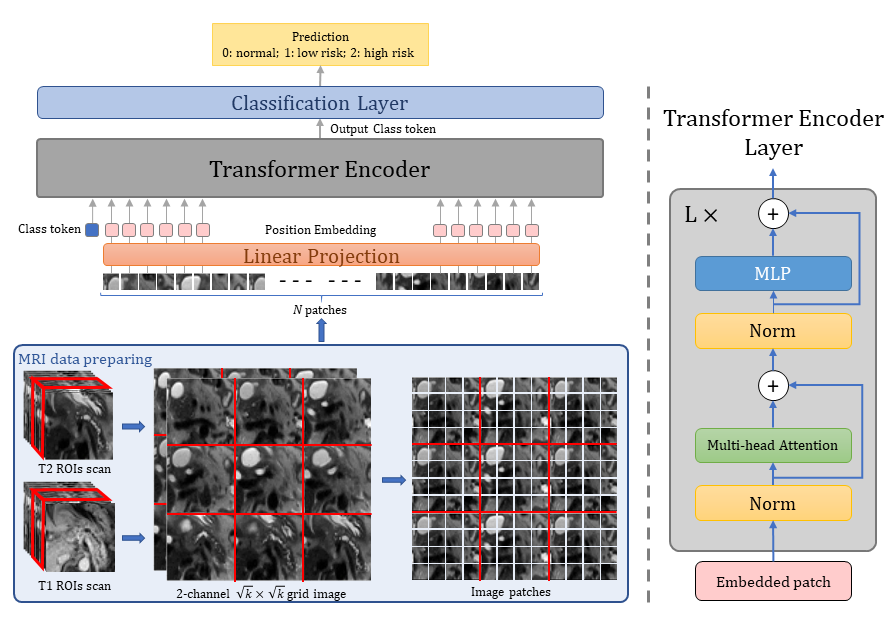Federica Proietto Salanitri, Giovanni Bellitto, Simone Palazzo, Ismail Irmakci, Michael B. Wallace, Candice W. Bolan, Megan Engels, Sanne Hoogenboom, Marco Aldinucci, Ulas Bagci, Daniela Giordano, Concetto Spampinato
Official PyTorch implementation for paper: "Neural Transformers for Intraductal Papillary Mucosal Neoplasms (IPMN) Classification in MRI images"
Early detection of precancerous cysts or neoplasms, i.e., Intraductal Papillary Mucosal Neoplasms (IPMN), in pancreas is a challenging and complex task, and it may lead to a more favourable outcome. Once detected, grading IPMNs accurately is also necessary, since low-risk IPMNs can be under surveillance program, while high-risk IPMNs have to be surgically resected before they turn into cancer. Current standards (Fukuoka and others) for IPMN classification show significant intra- and inter-operator variability, beside being error-prone, making a proper diagnosis unreliable. The established progress in artificial intelligence, through the deep learning paradigm, may provide a key tool for an effective support to medical decision for pancreatic cancer. In this work, we follow this trend, by proposing a novel AI-based IPMN classifier that leverages the recent success of transformer networks in generalizing across a wide variety of tasks, including vision ones. We specifically show that our transformer-based model exploits pre-training better than standard convolutional neural networks, thus supporting the sought architectural universalism of transformers in vision, including the medical image domain and it allows for a better interpretation of the obtained results.
The proposed transformer-based architecture. T1 and T2 slices are concatenated along the channel dimension and sequences of 9 consecutive slices are arranged in a 3×3 grid. Patches are then extracted from the resulting image,and are used as input to the transformer architecture. After encoding the pach set through transformer layers (consisting of a cascade of multihead attention block and MLP layers),a special classification token encodes global image representation, and is used for final classification into three IPMN classes: normal, low risk and high risk.
Comparison between the attention maps of some popular CNN-based models and our model in case of correct (top row) and erroneous (bottom row) predictions on a 3×3 grid of MRI images.
Attention maps of our transformer-based classifier on 3×3 grid of MRI images for correct IPMN classification.
The code expects a json file containing the image paths and their respective labels, formatted as follow:
{
"num_fold": #N,
"fold0": { "train": [ {"image_T1": #path,
"image_T2": #path,
"label": #class},
...
{"image_T1": #path,
"image_T2": #path,
"label": #class}
],
"val": [ {"image_T1": #path,
"image_T2": #path,
"label": #class},
...],
"test": [{"image_T1": #path,
"image_T2": #path,
"label": #class},
...]},
"fold1": { "train": [],
"val": [],
"test": []},
....
"fold#N": { "train": [],
"val": [],
"test": []},
}- NVIDIA GPU (Tested on Nvidia GeForce RTX 3090)
- Requirements
python main.py --name expName --dataset MRI-BALANCED-3Classes --image_modality EarlyFusion --model VisionTransformer --model_type ViT-B_16 --accuracy both --num_fold 0 --output_dir output/ --num_steps 3000-
This code is an adapted version of the original available here.
-
The ViT-B16 weights can be downloaded from here.
@inproceedings{salanitri2022neural,
title={Neural Transformers for Intraductal Papillary Mucosal Neoplasms (IPMN) Classification in MRI images},
author={Salanitri, F Proietto and Bellitto, Giovanni and Palazzo, Simone and Irmakci, Ismail and Wallace, M and Bolan, C and Engels, Megan and Hoogenboom, Sanne and Aldinucci, Marco and Bagci, Ulas and others},
booktitle={2022 44th Annual International Conference of the IEEE Engineering in Medicine \& Biology Society (EMBC)},
pages={475--479},
year={2022},
organization={IEEE}
}



